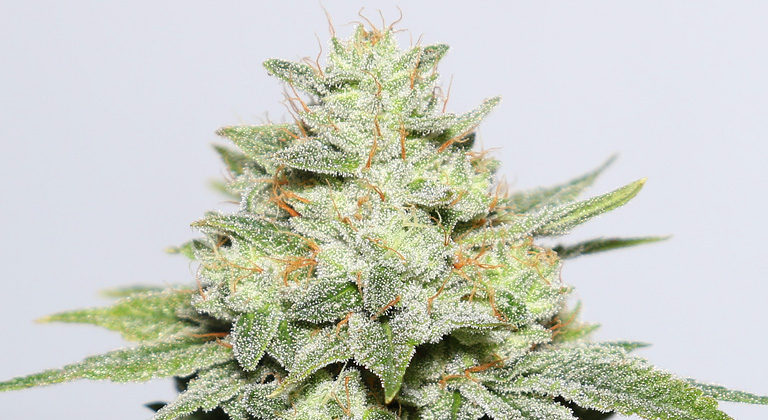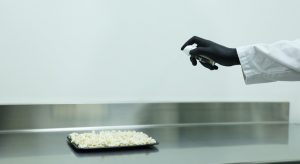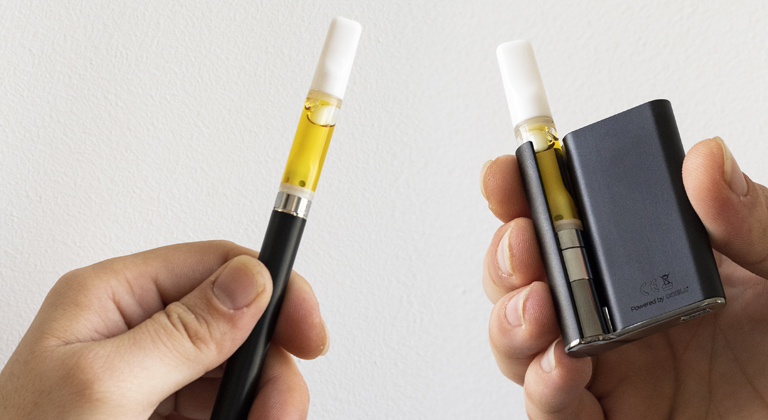Discover more about the cannabis strain Gorilla Glue, including its history, genetics, and qualities that have propelled it to the top of the global cannabis market for years.
What are the main terpenes found in Gorilla Glue?
Cannabis, a plant as complex as it is fascinating, offers a range of aromas and flavors that distinguish each of its strains, giving them a unique fingerprint.
However, certain strains stand out for particular characteristics (or a combination of several), becoming superstars in the cannabis market. This is the case with Gorilla Glue, one of the most famous strains on the market, known not only for its potent effects and aromatic profile but, above all, for its enormous production of sticky resin, earning it the title of one of the most famous adhesives in the United States.
In this article, we delve into the aromatic molecules, specifically terpenes, that make up the smell and taste of Gorilla Glue and detail the main terpenes of its delicious essence.
History of the Gorilla Glue cannabis strain
The origin of Gorilla Glue, one of the most recognized strains on the market today, is as curious as it is fortunate; it is, in fact, a happy accident. This strain, also known as GG4, is the result of the fortuitous crossing of Sour Dubb x Chem Sister and Chocolate Diesel.
The creation process of Gorilla Glue was unintentional, as growers were not aiming to give birth to a new cannabis strain; however, nature had other plans. Thanks to cross-pollination between the three strains we just mentioned, the world has been able to enjoy this gem that has an exceptionally rich terpene profile, a powerful yet balanced effect, and ultra-sticky resin.
As mentioned earlier, the name “Gorilla Glue” is inspired by the excessive resin production of this strain, a characteristic that is not only a delight to the senses but also an indicator of the high quality and potency of the strain.
This distinctive trait, along with its complex aromatic profile and balanced effects, has ensured that Gorilla Glue remains one of the most popular and sought-after cannabis strains in the market.
The history of Gorilla Glue is a reminder that sometimes the best discoveries happen by accident, leading to unexpected and exciting innovations in the world of cannabis.
What genetics does Gorilla Glue contain?
Gorilla Glue is a fascinating genetic tapestry woven in three strands: on one hand, Sour Dubb, an American strain known for its invigorating and socializing effect, adding a touch of uplifting energy. A strain with a profile dominated by Limonene, renowned for its exquisite Diesel flavor with hints of spices, herbs, and a delightful touch of plum.
Chem Sister, on the other hand, is a variant of the famous Chemdawg, known for its potent sedative effect and intense aromatic profile. This strain brings to Gorilla Glue a penetrating and complex aroma.
Lastly, Chocolate Diesel adds an additional dimension with its chocolate and coffee fragrances. This strain, derived from Sour Diesel, is known for its unique flavor and balanced effect, providing Gorilla Glue with an earthy and complex taste, along with a cerebral effect that stimulates creativity and focus.
The combination of these three strains has resulted in a hybrid strain that is much more than the sum of its parts. Gorilla Glue offers a balance between cerebral stimulation and body relaxation, with a flavor and aroma profile that makes it unique in the cannabis world. Its diverse genetics translate into a multifaceted experience that satisfies both recreational and medicinal users, making Gorilla Glue one of the most popular and respected strains in the cannabis community.
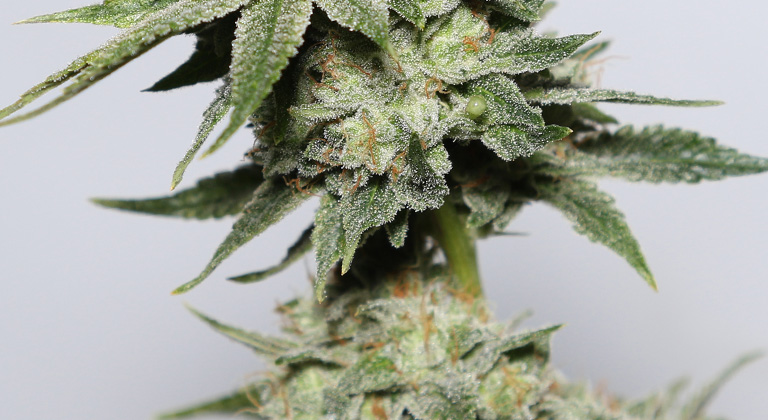
What terpenes does Gorilla Glue contain?
The terpene profile of Gorilla Glue is a fundamental part of its identity, significantly contributing to its aroma, taste, and effects, as terpenes play a crucial role in the sensory experience of cannabis and also influence the therapeutic effects of each strain.
When we started working on Gorilla Glue, we expected something different. It’s already one of the strains that we have seen offer the highest terpene returns, but what’s most interesting is the large amount of β-Caryophyllene it contains.
Although the terpene profile of this indomitable beast is composed of a wide multitude of these compounds, the main terpenes of the strain, (those found in larger quantities), are Caryophyllene, Myrcene, Limonene, and Humulene (from highest to lowest), followed by others in smaller amounts such as Linalool, Pinene, Terpinolene, and Nerolidol.
- Caryophyllene is the dominant terpene in Gorilla Glue, providing intense earthy and spicy notes, giving the strain a deep and robust aroma and flavor that may remind one of black pepper and cloves.
- Myrcene is an organic compound classified mainly as a hydrocarbon, specifically a monoterpene. This terpene is one of the main components of essential oils in most cannabis plants and other plants and flowers such as thyme, oregano, and hops.
- Limonene, on the other hand, is a terpene known for its refreshing and citrusy aroma. As the second most abundant terpene in this strain, it adds that refreshing and energizing touch, balancing the organoleptic weight of Caryophyllene with a citrus lightness.
- To top it off, Humulene, a terpene known to be found in large quantities in hops, adds interesting earthy and woody notes to the mix.
- These four main terpenes, along with all the others previously mentioned and the rest of the terpenes in smaller amounts, not only define the aroma and taste of Gorilla Glue but also enhance and modulate its effects (the well-known entourage effect) and therapeutic benefits.
Therapeutic properties of the main terpenes in Gorilla Glue
Next, we’ll delve a bit more into the aroma and specifically the properties of the three main terpenes in greater quantity in the terpene profile of Gorilla Glue, as these molecules are very interesting both in terms of qualities and therapeutic effects.
β-Caryophyllene
The most abundant terpene in Gorilla Glue’s terpene profile is Caryophyllene, a molecule with multiple properties that are commonly found in the aromatic composition of cannabis plants, with the particularity that it’s also found in a really high proportion.
The original function of this terpene in nature is to act as a natural protector against fungi and insects, influencing the plant’s ability to stay healthy and free from pathogens.
But coming back to what interests us most as a species, this terpene also possesses properties that can be very useful therapeutically for humans:
- Anti-inflammatory properties: as it modulates the signaling mechanism of prostaglandins (cellular mediators in various functions).
- Analgesic: there is research indicating the power of β-Caryophyllene to relieve pain, being used, for example, in conditions such as dermatitis.
- Antifungal: several studies determine that Caryophyllene is effective in fighting some types of fungi.
- Anticoagulants: helping blood circulation, in addition to offering protection to the digestive cellular system.
- Interaction with the endocannabinoid system in our body: interestingly, this terpene is currently the only one known to act on the CB2 cannabinoid receptor, being one of the few non-cannabinoid compounds known to emulate their action. There is also evidence suggesting that β-Caryophyllene helps alleviate periods of anxiety or depression.
Myrcene
The second most present terpene in this aromatic profile is Myrcene, despite being in a much smaller proportion compared to β-Caryophyllene.
- Analgesic and relaxing: there is a multitude of studies on the analgesic effects of myrcene, acting as a calming, sedative, and muscle relaxant.
- Anti-inflammatory: it acts as an anti-inflammatory by interfering with the signaling channel of prostaglandins (just like β-Caryophyllene). Allows better absorption of cannabinoids: Myrcene can increase the permeability of the blood-brain barrier, thus increasing the bioavailability of cannabinoids such as CBD or THC.
Limonene
The third most abundant terpene we find in Gorilla Glue is Limonene, being one of the terpenes that provide a more stimulating effect that counteracts the relaxing effects of others such as β-Caryophyllene and Myrcene. This terpene profile follows this trend in the rest of its aromatic profile, so it’s not surprising that users find it challenging to agree on the effects it provides at any given moment, ultimately making it a fairly balanced strain in terms of effects.
Limonene also has beneficial properties, among which we can highlight:
- Improving the mood: given the natural energizing effect of Limonene, it can improve moods, and clinical trials have determined improvements in people with low endocrine hormone levels.
- Antifungal: Limonene inhibits the proliferation of some fungi, especially those affecting food products.
- Anti-inflammatory: there are various studies confirming the potential of Limonene to relieve inflammation and help metabolize carcinogenic substances in mammals.
Other main terpenes in Gorilla Glue
- α-Humulene (also known as α-Caryophyllene)
- Linalool: sedative and anxiolytic properties. Traditionally used to treat anxiety and insomnia.
- Pinene: has anti-inflammatory properties and has been traditionally used to help improve memory and concentration. It also has bronchodilator properties.
- Terpinolene: anxiolytic, antioxidant, antimicrobial, and antibacterial properties.
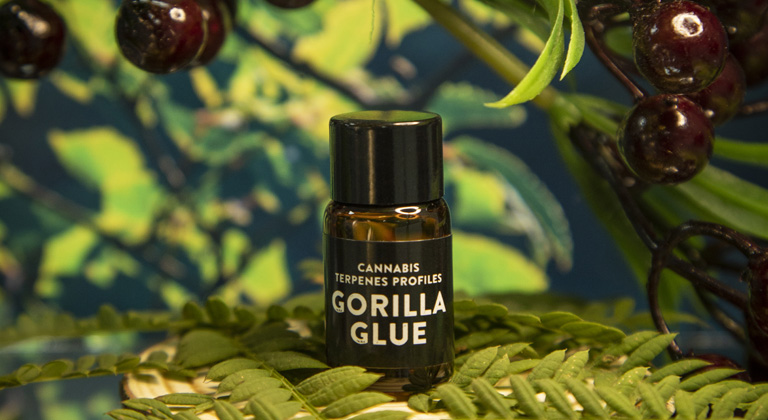
What’s the Flavor and Aroma of Gorilla Glue?
This strain has a highly distinctive aroma; when you experience Gorilla Glue, that scent lingers in your mind.
The captivating aroma of Gorilla Glue is an almost singular olfactory experience, as it possesses a highly characteristic fragrance.
The essence of Gorilla Glue stands out for its deep and penetrating aroma, unfolding a myriad of notes as you focus your senses on its fragrance.
The overwhelmingly dominant presence of β-Caryophyllene imparts an unmistakable earthy richness to this bouquet, as if you were exploring a jungle or rainforest.
The pungent touch, reminiscent of the freshness of pine, skillfully intertwines with the earthy intensity, creating an olfactory harmony that will stick with you.
The sweet notes interweaving with the other terpenes add a soft and enjoyable dimension to the overall experience.
In summary, Gorilla Glue’s aroma is not just a fragrance, it’s nature’s blessing (given its history) that has allowed the cannabis world to savor a new aromatic delight.
What effects does Gorilla Glue cannabis produce?
Gorilla Glue and its composition of cannabinoids, terpenes, and other elements provide a balanced effect, as explained above, containing elements that deliver relaxing effects and others that offer stimulating effects.
With that said, this strain is commonly described by most users as having a potent yet balanced effect, providing creativity and mental energy, along with relaxing effects on the body.
Moreover, Gorilla Glue is a strain that many users highlight for its stress-relieving properties, mood enhancement, and appetite stimulation.
Are you also a fan of this exquisite strain? Leave your comment below and share your opinion with the community!
Cali Terpenes

